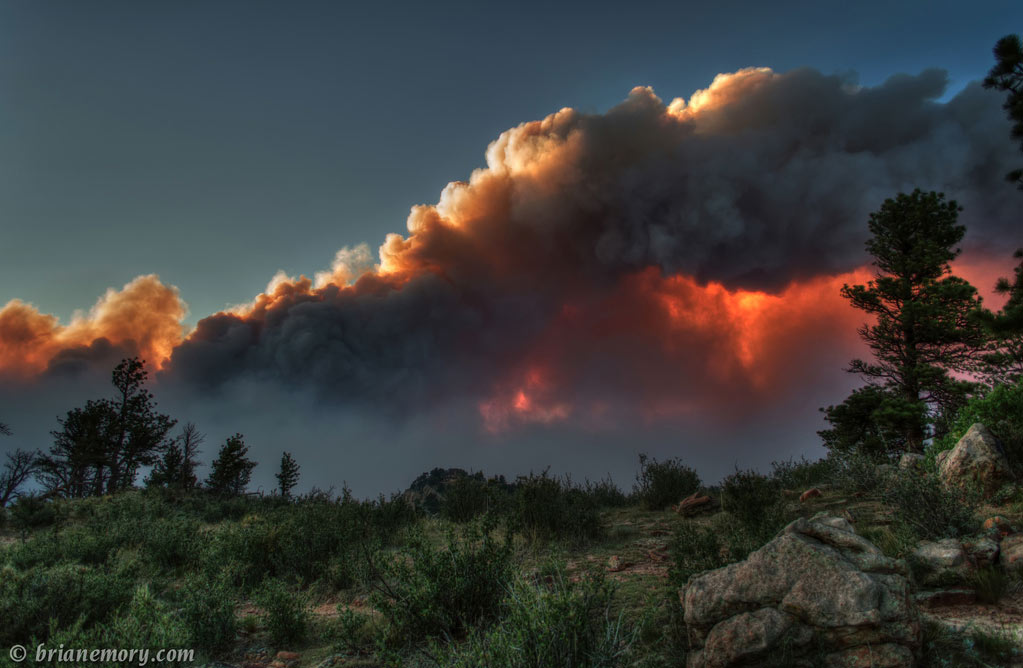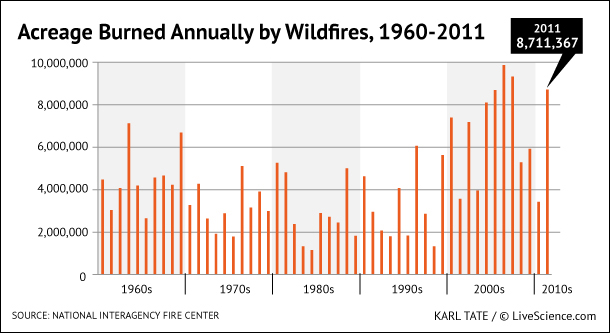Is Global Warming Fueling Colorado Wildfires?

DENVER — Devastating wildfires scorching the state of Colorado are linked to a nasty streak of hot weather across the central part of the country, but it's tougher to link them definitively to global warming, climatologists say.
Earlier research has found broad trends linking earlier spring weather, rising temperatures and increased forest fires, suggesting that climate change may play a role in fires like the Waldo Canyon blaze outside of Colorado Springs, which has burned more than 18,000 acres and consumed about 300 homes here. But linking a specific fire to the long-term trend of global warming isn't possible.
"You can't say it's climate change just because it's an extreme condition," said Colorado state climatologist Nolan Doesken. So far, Doesken told LiveScience, the spring of 2012 looks much like the spring of 1910, when warm temperatures hit early. That year, he said, was a bad one for fires. [Images: Devastating Colorado Fires]
Fire weather
The Waldo Canyon fire began on June 23 and has ripped through neighborhoods west of Colorado Springs, destroying a yet-unreleased number of homes. Just 130 miles (209 kilometers) to the north, the High Park wildfire outside of Fort Collins is well into its second week and has burned more than 87,000 acres. That fire killed one 62-year-old woman who was caught in her home.
Other significant fires in the state include a 300-acre blaze 1.5 miles (2.4 km) outside of Boulder, a 9,168-acre blaze near Mancos in the southwestern part of the state and a 23,400-acre wildfire in rugged terrain in the San Juan National Forest, also in the southwestern part of the state.
The immediate driver of these fires is a lack of moisture and a ridge of heat that has settled over the central United States, said New Jersey state climatologist Dave Robinson, who also directs the Global Snow Lab at Rutgers University. After record snowpack last year, the Rocky Mountains did a 180 this year, Robinson said, seeing little moisture and early snowmelt.
Get the world’s most fascinating discoveries delivered straight to your inbox.
"March and April are supposed to be your snowy months [in Colorado], and they weren't," Robinson told LiveScience. "Thus, the fire danger."
Meanwhile, a high-pressure system in the central part of the country is preventing cloud formation and allowing the sun to bake the ground, heating things up. On Tuesday (June 26) alone, 251 daily heat records were broken across the nation, according to the National Climatic Data Center. In the past week, more than 1,000 new daily heat records were put on the books. [The World's Weirdest Weather]
function reload_quiz_ads(){ reloadScripts(null, ['ad_imgBoard', 'ad_imgViewer']); }
Climate change connection
Climate models predict that in a warming world, the West and Southwest will become drier and hotter — conditions ripe for wildfires. Whether recent hot summers and active fires are a sign of the change already happening is still under debate, though.
"Some would say there is a pattern, because we have had several years with exceptionally large fires over western states, particularly the Southwestern states, Arizona, New Mexico, Texas and Colorado in particular," Doesken said. "Others would say, no, not enough data points yet to show that."
This year has been extreme in terms of heat and dryness, he said, as was 2002 (a record-breaking year for fires in Colorado). So far, 2012's weather looks very similar to the weather of 1910. That year, spring was warm and dry, which fed into a hellish fire season. Among the blazes was the Great Fire of 1910, also known as "the Big Burn," which destroyed 3 million acres of forest in Washington, Idaho and Montana.
Some studies do suggest that climate change is already affecting western wildfires. In 2006, researchers at the Scripps Institute of Oceanography in California analyzed 1,166 fires between 1970 and 2003 and found a dramatic increase in fire potency in the late 1980s. Though wildfire is a natural part of the western landscape, the researchers concluded that a warming climate was ramping up warm winters and springs, exacerbating natural fire cycles.
More recently, an analysis of 1,500 years of fire and tree-ring data revealed that a combination of climate change and human forest use could explain modern "megafires," the kind that destroy large swaths of forest. Fires were associated with a dry year following several wet years, because the moist periods allow undergrowth to spring up and provide fire fuel in dry years, researchers reported in May in the journal The Holocene. The study found that human activities such as livestock grazing and suppression of small fires compounded the problem, creating denser forests ripe for large blazes.
Follow Stephanie Pappas on Twitter @sipappas or LiveScience @livescience. We're also on Facebook & Google+.

Stephanie Pappas is a contributing writer for Live Science, covering topics ranging from geoscience to archaeology to the human brain and behavior. She was previously a senior writer for Live Science but is now a freelancer based in Denver, Colorado, and regularly contributes to Scientific American and The Monitor, the monthly magazine of the American Psychological Association. Stephanie received a bachelor's degree in psychology from the University of South Carolina and a graduate certificate in science communication from the University of California, Santa Cruz.



